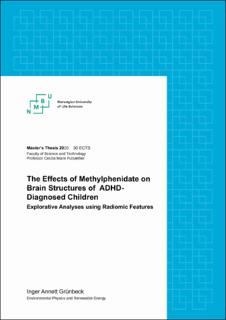| dc.description.abstract | The main objective of this thesis was to examine whether the treatment of ADHD-diagnosed male children using methylphenidate-based medication (MPH) caused changes to selected subcortical brain structures. The effects of MPH were examined by comparing MPH-treated trial subjects to a placebo cohort. Radiomics was utilised to extract high-dimensional datasets from T1-weighted MR images, which were obtained as part of The effects of Psychotropic drugs On Developing brain study (ePOD). The analyses performed in this thesis were limited to the trial subjects' caudate, hippocampus, pallidum, putamen and thalamus.
Radiomic shape and texture features were extracted from the left and right side of the selected brain structures and analysed. The analyses included a comparison of the subjects' structure surface area and volume and a principal component analysis of the extracted shape and texture features. Further, classification experiments were performed, predicting the treatment method by cross-validating six classification algorithms and four feature selectors. The performance of the classification experiments was evaluated using the area under the receiver operating curve (AUC).
According to the analyses performed, the subjects' right pallidum's suface area and volume were enlarged after methylphenidate-treatment. Furthermore, the MPH-treated trial subjects showed signs of an increased right hippocampal volume and right thalamus surface area. None of the principal component analyses performed based on the shape features or the texture features appeared to be able to distinguish the MPH-treated subjects from the placebo group, indicating that no changes due to the medication were detected by the principal component analyses.
The classification experiments of the pallidum and the putamen associated features yielded AUC scores close to 80. The best performing models in the caudate's, hippocampus' and the thalamus' classification experiments resulted in AUC scores close to 65, 75 and 70, respectively. The highest AUC scores were achieved by combining the Variance Threshold feature selector with either the Decision Tree classifier or the Extremely Randomised Tree classifier, or by combining the Light Gradient Boosting Machine classifier with either the Fisher Score or ReliefF feature selectors. The AUC scores achieved by the classification experiments combined with the identified changes in the structures' surface area and volume, indicated that MPH-medication may cause detectable, significant changes in male childrens' brain structures which should be examined closer. | en_US |

